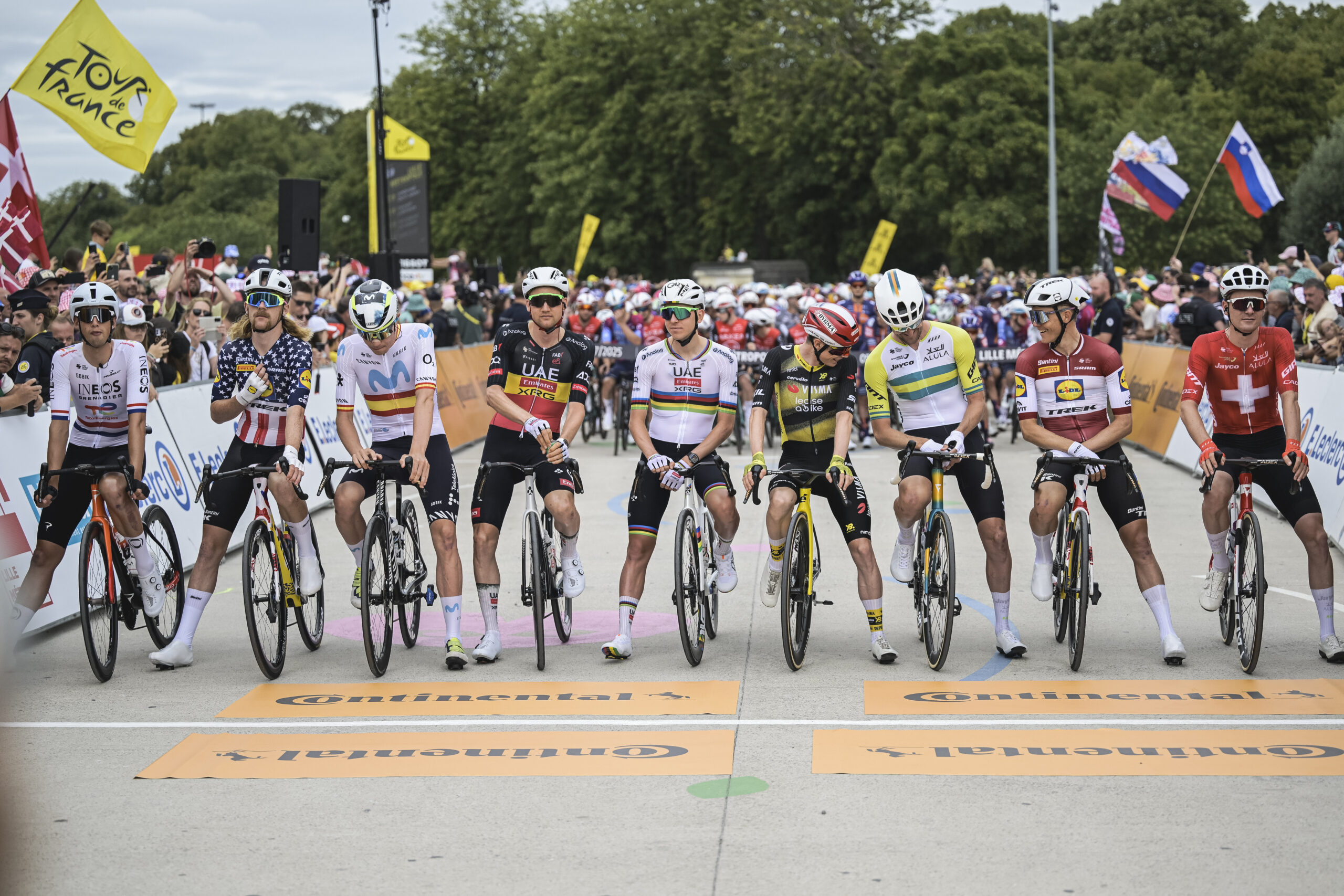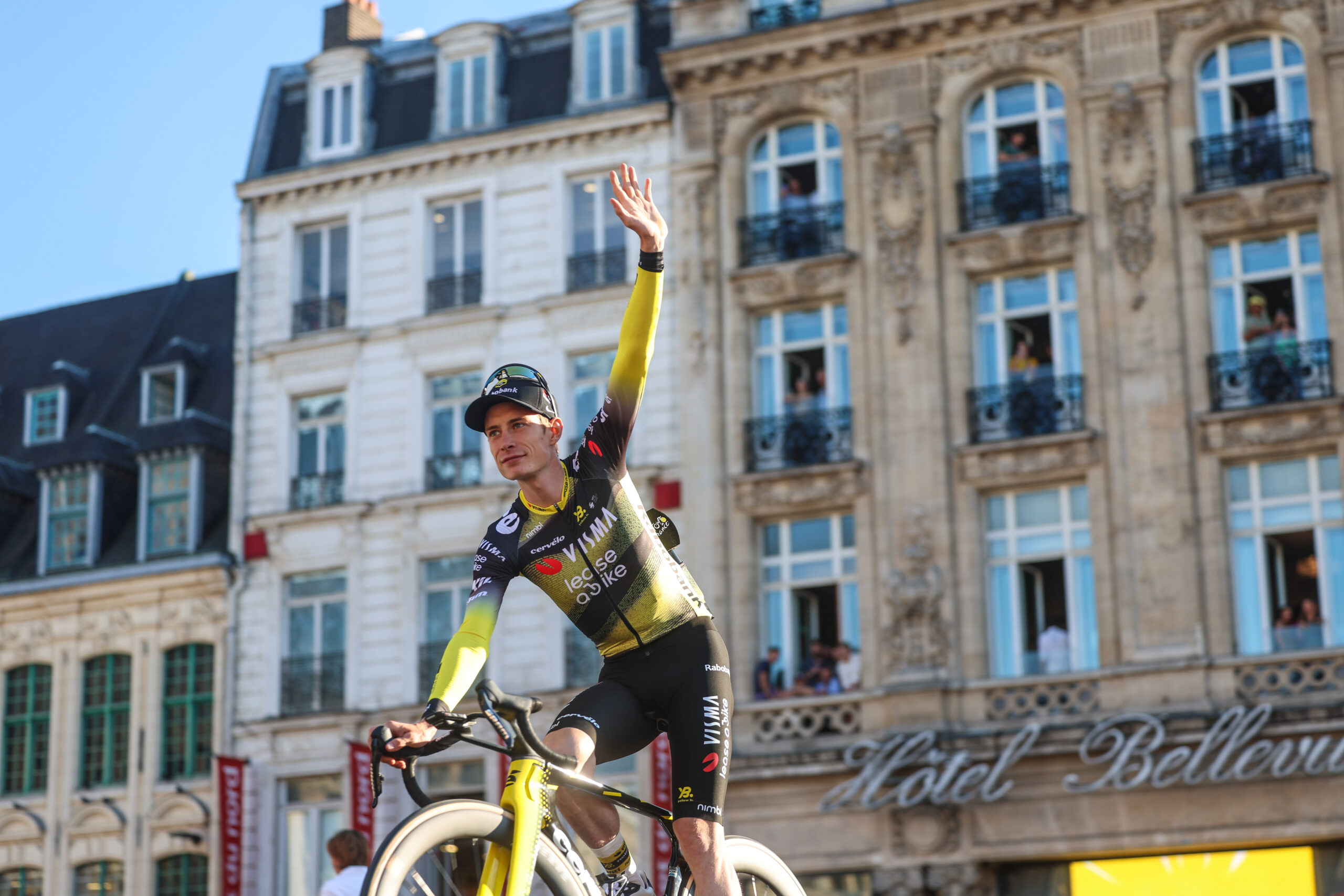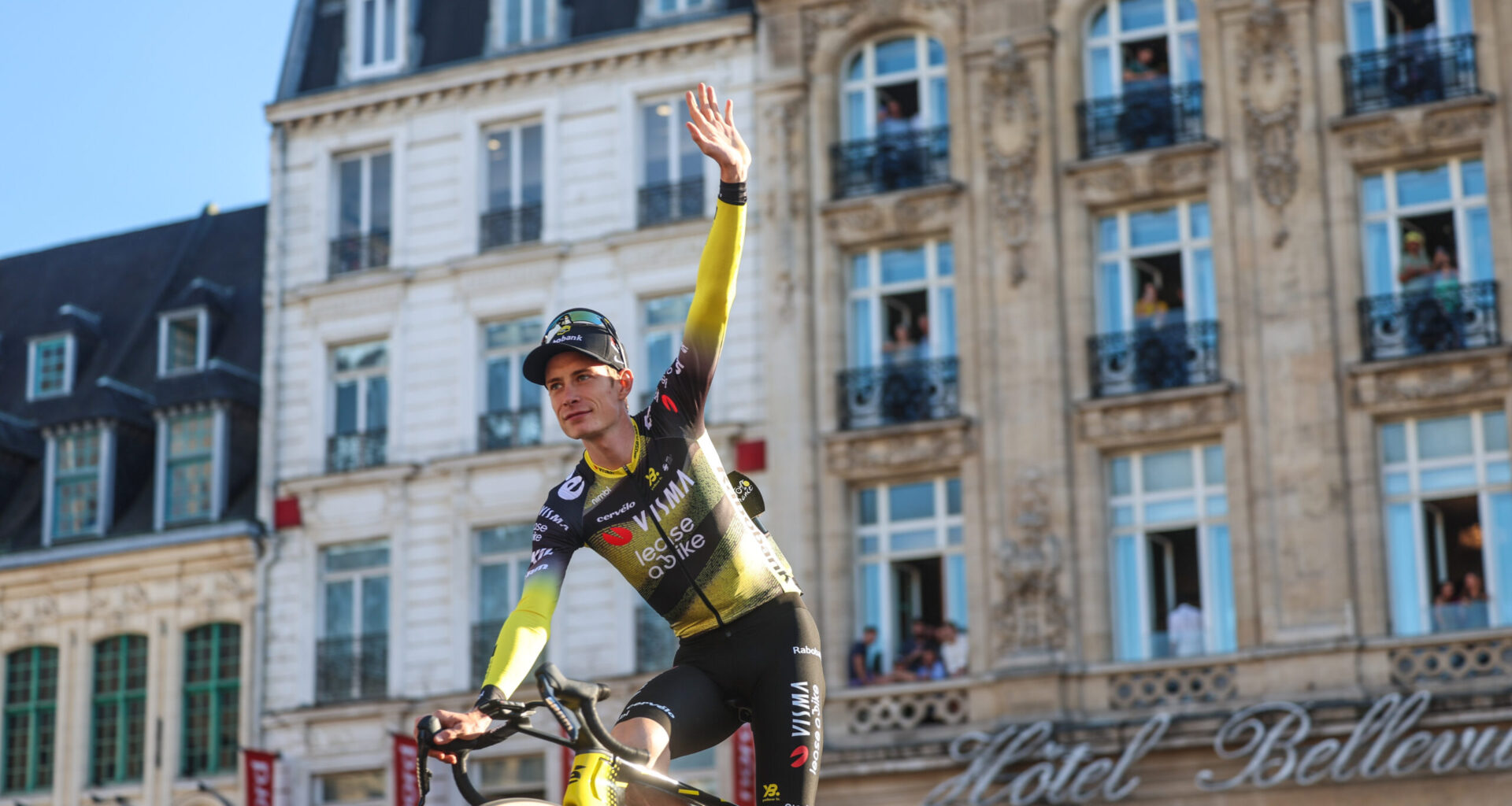Recognized worldwide as the ultimate test of endurance, superhuman fitness, and mental toughness, the Tour de France (TDF) is often hailed as one of the most gruelling bike races on the planet. But let’s be honest, multisport racing can be just as hardcore.
The sheer endurance and physical grit it takes to power through a three-discipline race for hours on end is arguably on par with the next-level fitness demanded by the TDF. As triathletes, we’re no strangers to punishing race conditions and epic distances.
The TDF spans 21 stages over 23 to 24 days. You don’t need to be a mathematician to figure out that rest is minimal. So, how do these cyclists, superhuman as they may seem, reach such staggering levels of fitness? And more importantly for us, how can triathletes tap into those same strategies to elevate our own multisport training and performance?
The 2025 Tour de France and Tour de France Femmes
With the 2025 Tour de France just getting underway (July 5-27) and the Tour de France Femmes set to begin two days before the men’s infamous Champs-Élysées finale, the world’s best cyclists should now be in fighting shape and raring to go.
The 2025 TDF will see 184 riders in 23 teams set out on the 3-week tour. This year, the all-French tour sets off in the north of France, past the D-day beaches of Normandy and into the stunning chateau region of the Loire. After a rest day in Toulouse, they’ll get a taste of the Pyrenees, going on to some of the toughest climbing in the Alps, before hitting the Champs-Élysées.
Despite a flat start, which will lend itself to the sprinters of the peloton, the race will ultimately be won and lost up iconic climbs of the Col du Tourmalet, Mont Ventoux, Col de la Loze, and the highest point of the tour, La Plagne. Three-time defending champion Tadej Pogačar will be back to defend his yellow jersey, alongside fellow 2024 podium finishers Jonas Vingegaard and Remco Evenepoel.
The fourth iteration of the relaunched Tour de France Femmes avec Zwift (TDFF) sees the race extended to nine consecutive stages (26 July – 3 August), taking in the rolling hills of Brittany before traversing the Massif Central to finish in the Alps. With plenty of elevation and likely searing temperatures, previous TDFF winner Kasia Niewiadoma will be gunning to defend her crown against tough competition from previous champion, Demi Vollering, and returned retiree and Olympian, Anna van der Breggen.
A blueprint to superhuman endurance
As a triathlete, you might think you’re used to big training weeks. Maybe you’ve put in a 20-hour block before or you’re no stranger to knocking out back-to-back long rides and runs. But the TDF is an entirely different level of load, and there’s a whole lot that we can learn from the pros and how they train.
Few athletes have the ability to complete, let alone compete in, the Tour de France. Over those 21 stages, the pros will cycle more than 3,500km and take on over 51,000m elevation, with just two rest days in the 2025 schedule. Some stages will hit 4,000m of elevation in a single day, with daily distances ranging from 128km-209km (not including time trials).
 Tour de France 2025 – Étape 1 – Lille Métropole / Lille Métropole (184,9 km) [Photo: Charly Lopez / A.S.O
Tour de France 2025 – Étape 1 – Lille Métropole / Lille Métropole (184,9 km) [Photo: Charly Lopez / A.S.O
Meanwhile, the nine-day women’s TDFF covers more than 17,000m of elevation, that’s almost twice the height of Everest! Pro cycling isn’t just tough, it’s controlled suffering at scale. Riders aren’t merely surviving each day, they’re pushing thresholds, chasing breakaways, and emptying the tank, then doing it all again tomorrow.
And yet, there’s a structure to it. Tour riders spend years building huge aerobic bases with consistent high-volume training. Not all of a pro’s rider’s training is brutal. In fact, most of it is steady. That translates to long, controlled sessions in Zone 2, back-to-back days on the bike, tempo rides, and the occasional VO2 max workout when it counts.
Build the engine slowly. There’s power in consistency, take it from Pogačar, who says to all those looking to beat him on the climb: “My first tip is to train consistently throughout the whole year, no excuses.”
What can you take away from that as a triathlete? If you’re serious about endurance triathlon racing, start treating your training like a stage race. Layer your long sessions. Practice stringing them together across two or three days. Don’t forget to respect the easy sessions and rest days, the TDF is proof that even the elites need rest, and so do you.
Rest is something that returning champion Niewiadoma can agree on too: “Without proper recovery, you’re just accumulating fatigue instead of making real progress”, she discusses in an interview with Škoda We Love Cycling. “It took me years to understand just how important rest is. If training were the only factor in performance, we’d all be riding 10+ hours a day! But the real progress happens when the body adapts to the hard work.”
Adapting to extreme heat and altitude
In the TDF it’s not a question of if an athlete will suffer, but when. Typically, it’s either the mountains or the heat, for most, it’s both. Riders face Alpine climbs topping out over 2,304m, before going on to race through exposed valleys over searingly hot tarmac. In recent years, temperatures have soared well past 35°C. That’s not just uncomfortable, it’s performance-altering.
Altitude training
The pros know it. That’s why they spend time at altitude training camps based between 1,800–2,500m for weeks on end. Ahead of this year’s grand depart, the main tour riders headed to their final altitude camps. Post-Dauphiné victory, race favourite Pogačar with team UAE have once again opted for a camp in the French ski resort of Isola at 2000m, while fellow pros Vingegaard, Evenepoel, and Primož Roglič based themselves in Tignes at 1810m.
 Two-time Tour de France winner Jonas Vingegaard is one of many pro cyclists who spent time training at altitude ahead of the 2025 TdF [Photo: Charly Lopez / A.S.O]
Two-time Tour de France winner Jonas Vingegaard is one of many pro cyclists who spent time training at altitude ahead of the 2025 TdF [Photo: Charly Lopez / A.S.O]
Training in high-altitude conditions for at least two weeks can increase aerobic capacity (VO2 max) and oxygen flow to the muscles, as well as tolerance to lactic acid. Since the air at altitude contains less oxygen, the blood learns to expand and drive more oxygen to the muscles. The higher the oxygen intake, the better the capacity for endurance. Since the body maintains these natural performance benefits for 3-4 weeks, the pros tend to transition almost straight from their final altitude camp to the TDF start line, which this year was in the northern French city of Lille.
If you’re planning to train and race for triathlon at altitude, give yourself time to adapt. Altitude impacts sleep, hydration, pacing, and recovery. Ignore this and you’ll feel it by race day. While you may not have the means or time to jet off to an altitude training camp as an age-group triathlete, the next best thing would be to arrive 10-14 days before the start of a high-altitude race, this will allow the body to start adapting.
Alternatively, aim to arrive just 24-36h before the race start to avoid negative effects of poor sleep and sluggish legs. Obviously, you won’t have adapted to the altitude in such a short timeframe, so if you’re doing this, just be sure to manage expectations, pace conservatively, and focus on getting in enough hydration and energy on race-day.
Heat training
In some ways, sweating it out in the heat can mimic altitude training by boosting haemoblobin (blood oxygen) and aerobic efficiency. By elevating core temperature and sustaining thermal stress, the body expands plasma volume to improve cardiovascular efficiency, oxygen delivery, and thermoregulation, all of which are crucial for long climbs and sustained efforts.
At this point, sweating becomes more efficient, aiding temperature control. Over time, heart rate decreases at a given output, reflecting improved cardiac function and cooling ability. Emerging research also suggests heat exposure boosts mitochondrial efficiency, which enhances aerobic energy production and performance during endurance efforts, like those say of a multi-day Grand Tour.
 At the Tour de France, the riders and the fans have to be ready to beat the heat! [Photo: Tour de France 2024 – Charly Lopez / A.S.O.]
At the Tour de France, the riders and the fans have to be ready to beat the heat! [Photo: Tour de France 2024 – Charly Lopez / A.S.O.]
With the TDF getting hotter every year, heat adaptation is key. In 2024, stage one saw the heat rise to heights of 40˚C! Finding strategies to cope in the heat for TDF riders is not only smart, but essential to health and wellbeing. And it’s also why you, as a triathlete, should start thinking the same way. EF Pro Cycling head doctor, Jon Greenwell, shares the team’s two main techniques for heat accilmatisation that triathletes can do too:
“One is to ride inside on a turbo trainer at intensity and without a fan to increase your core body temperature to at least 38.5˚C. This may include heating up the room in advance or wearing additional layers like arm warmers, rain jackets, and a hat. Some riders will even wear a painter’s suit in order to really get sweating. Maintain this for about 45-75 minutes. The other way is to take a hot bath, usually at 40˚C. Sitting in the bath will raise your core temperature, helping your body to adjust to the heat.”
TT superstar Evenpoel discusses this on his YouTube channel, too. By using a Core sensor, he tracks his body temperature alongside heart rate during a 1min above/3min below threshold turbo session. “The goal is to go to 38.5 °C, which means I will have fever on the bike and that’s the heat adaptation training”, he explains. With his body literally beginning to steam, he adds with a smile: “like this, I’m always going up and down to really heat up the body”.
How to prepare for hot weather racing
Start heat-adapting at least 2–3 weeks out from race day, or preferably longer if you’re able to and live in a warm climate. This will ensure you’re in top form on D-day, and help to avoid suffering from heat stroke. Other tools the pros use to cool down include ice vests, pouring water over their heads, and ice ‘slushie’ gels. While you may not have a support crew following your every move, try to think of what techniques you can do to keep yourself cool in the heat and minimise the harmful effects of overheating as much as possible.
Meanwhile, one thing you can do is to dial in your hydration strategy. Elite cyclists will have this narrowed down to an exact science, and there’s no reason why you can’t do the same. For age-groupers racing triathlon in the heat, make sure you’ve practiced your race-day nutrition and you’re used to taking in sufficient fluids, electrolytes, and salt tablets to stave off dehydration.
Electrolytes like sodium and magnesium help regulate how much water your body retains, while also playing a key role in keeping your nerves firing and muscles working properly. To build a fully personalised strategy, there are plenty of sensors or labs that can accurately measure your individual rate of sweat and sodium loss.
Mental fitness strategies of the world’s best cyclists
You might think that you have it all down pat when it comes to training and giving your body the best chance to adapt to the heat and racing at altitude. Like the pros, maybe you’ve built the stamina to perform over long distances, and you’ve built up your fitness to manage training or racing across consecutive days. Job done, right? Not quite.
None of the physical training and physiological adaptations matter if you don’t have the mental endurance and self-belief to put yourself in a competitive position on race day, and stay there. There’s a lot of mental pressure that comes part and parcel with the job title of a TDF peloton rider. Whether as a domestique or a team leader, there’s a job to do. Literally.
When cycling and being part of a successful finish for your team is an athlete’s bread and butter, there’s a certain layer of pressure that’s hard to shift.
 [Photo Credit – Getty Images]
[Photo Credit – Getty Images]
Then, there’s the typical race nerves, confidence wobbles, and severe physical strain of racing that we’ve all felt to a certain degree when it comes to race day. It’s no wonder even the best of us crack sometimes, which is why mental fitness is essential for all athletes and triathletes, no matter your level.
Long-time partner and fiancée of Pogačar, pro cyclist Urska Zigart shares a similar sentiment in an interview with her new team AG Insurance earlier this year: “I know what he [Pogačar] has to sacrifice for it. Getting to the top is one thing. Staying at the top is much harder. Everyone looks at you and expects only the best. You should not underestimate that pressure.”
Just how do the pro riders cope with the mental stress of putting themselves in the limelight, with pressure from the team, sponsors, and themselves to deliver, day after day?
TDFF 2023 winner Vollering uses visualisation as a tool to calm the nerves and hone focus. Speaking with sponsor Maurten, she shares: “”During the race I am focused — just like every other race. I know the plan of our team and focus on my job for that day. Before every stage I do 10 or 15 minutes of yoga as soon as I wake up and then on the way to the start I always do some meditation to control my breathing.”
Not only do athletes need to prepare for race day, they also need to have the resilience to cope with setbacks. “For me, my failures and low moments are what drive me to push harder. When things are going well, I tend to take them for granted—but if I have a tough race or miss the final selection, I use that as fuel for my training”, Niewiadoma explains.
Triathletes who suffer from race nerves or who tend to doubt their abilities could benefit from adopting some of her favourite mantras to push through those hard moments: “It’s going to hurt, but it will end soon”, “I’ve been through worse, and I survived”, and “the stress means I care.”
